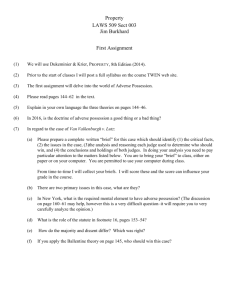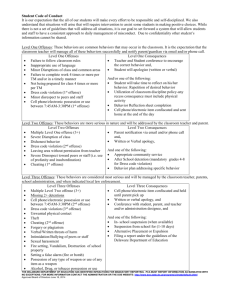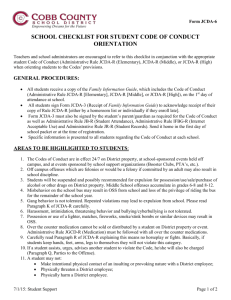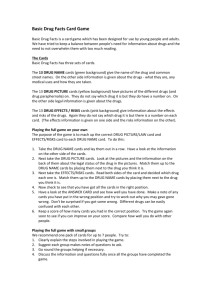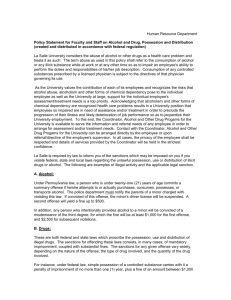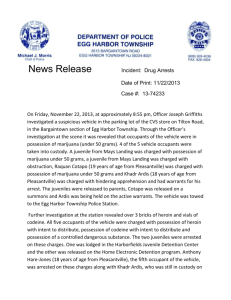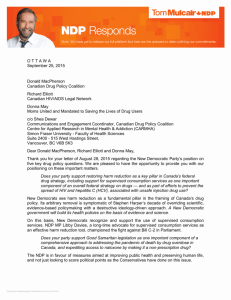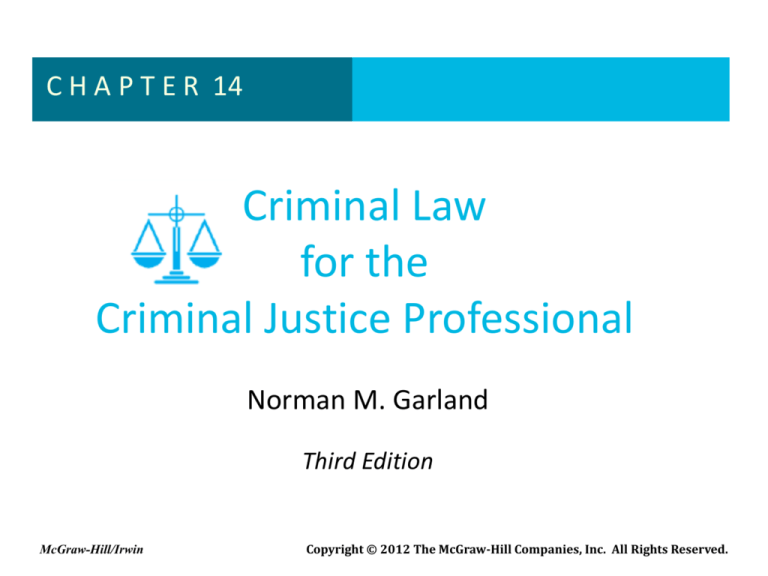
C H A P T E R 14
Criminal Law
for the
Criminal Justice Professional
Norman M. Garland
Third Edition
McGraw-Hill/Irwin
Copyright © 2012 The McGraw-Hill Companies, Inc. All Rights Reserved.
C H A P T E R 14
Drug- and
Alcohol-Related Crimes
Slide 14-2
14.1
14.2
14.3
14.4
Types of Psychoactive Drugs
History of Drug Legislation
in the United States
Drug Offenses
Alcohol Legislation and Offenses
CHAPTER OBJECTIVES
Slide 14-3
1.
2.
3.
4.
Identify the five major
categories of controlled substances.
State the purposes and effect of
the Uniform Controlled Substances Act.
Recognize and describe the difference
between actual and constructive
possession of a controlled substance.
State the difference between the
offense of possession and the offense
of possession with intent to deliver.
CHAPTER OBJECTIVES
Slide 14-4
continued
5.
6.
7.
8.
Define the drug offenses of delivery,
drug conspiracy, drug loitering, and
possession of drug paraphernalia.
Understand when drug addiction is
and is not a defense to drug offenses.
State the elements of
driving under the influence.
Define the extent to which alcoholism
can be a defense in a criminal case.
14.1 Types of Psychoactive Drugs
Slide 14-5
• Some drugs that affect mental states
and behavior have been subject to little or
no regulation, and others have been
targets of extremely punitive legislation
controlled substance
Any substance that is strictly regulated or outlawed
because of its potential for abuse or addiction.
psychoactive drug
A drug that has the ability to alter mood, anxiety,
behavior, cognitive processes, or mental tension.
Stimulants
Slide 14-6
• Directly affect central nervous
system and tend to produce
arousal, alertness, or excitation
– Include amphetamines, methamphetamines,
cocaine, caffeine, nicotine, and Ritalin
– Crack cocaine most commonly
associated with urban poor
Depressants
Slide 14-7
• Depress or slow down activity of central
nervous system and tend to produce
drowsiness, relaxation, or sleep
– Divided into narcotics (derived from opium
or opium-like compounds) and non-narcotic
• Opiates (opium, morphine, heroin, codeine)
derived from unripe poppy seed capsules
• Non-narcotic general depressants include
alcohol, barbiturates, and tranquilizers
Hallucinogens
Slide 14-8
• Act on central nervous system to cause
visual or auditory hallucinations
– Include LSD, PCP,
mescaline and peyote,
psilocybin, and numerous
synthetic drugs
– Use of LSD declined
sharply since 2000
Marijuana
Slide 14-9
• Consists of dried leaves and “tops” of
Cannabis sativa, the hemp plant
– Drug has been classified as a
hallucinogen, a stimulant, and a depressant
– Effectiveness of marijuana for medicinal
purposes widely contested, and efforts
to legalize have met with little success
Inhalants
Slide 14-10
• Classified by method of use
rather than by their effects
– Stimulate with very short-lived effects
– Include amyl nitrite and nitrous oxide
– Other household chemicals used as
inhalants not legally considered drugs
Designer Drugs
Slide 14-11
• Synthetic drugs that mimic effects of
known illegal drugs but are not listed as
controlled substances by the DEA
– Ecstasy chemically related to
amphetamines and mescaline
– FDA classified it controlled substance in
1985 but continued to grow in popularity
Steroids
Slide 14-12
• Consist of natural and synthetic hormones
that promote cell and muscle growth
– Steroid abuse
commonly by
athletes at
all levels
– Steroid rage can
lead to
aberrant behavior
Slide 14-13
14.2 History of Drug Legislation
in the United States
• Marijuana and the opium poppy
used as intoxicants and in rituals in
many societies for thousands of years
– Alcohol “a human
cultural universal”
– World trade in
substances began
after European
colonization
of America
Slide 14-14
Drug Use in
Nineteenth-Century America
• Narcotics
– Legal to distribute, promote,
and sell narcotics in 19th century
• Opium used to treat everything from
teething pain to tuberculosis and
was source of recreational pleasure
• Concerned about addictive
potential of opiates by end of 19th century
• Heroin first introduced by the Bayer
Company in 1898 as a cough medicine
Slide 14-15
Drug Use in
Nineteenth-Century America
• Cocaine
– Widely used in U.S. after chemically
extracted from coca leaf in 1844
– Many patent medicines of the late
nineteenth century contained cocaine
– Ingredient in Coca-Cola until 1903
– Widespread use of drugs gave rise to
demands for government regulation
Slide 14-16
Drug Legislation from
the 1800s to the Present
• Beginnings of Federal Legislation
– 1888: Federal restrictions on smoking opium
– 1909: Smoking opium banned,
but drinking it remained legal
– 1906: Federal Pure Food and
Drug Act required product labels to
specify the amount of drugs in product
Slide 14-17
Drug Legislation from
the 1800s to the Present
• The Harrison Narcotics Act of 1914
– Required persons dealing in narcotics
or cocaine to register and pay tax
– Legal to use cough medicine that
contained a restricted amount of
heroin, and physicians could still
prescribe opiates for medical treatment
• Webb v. United States
Slide 14-18
Drug Legislation from
the 1800s to the Present
• The Marijuana Tax Act
– Use and sale of marijuana
legal in U.S. until 1930s
– Marijuana Tax Act of 1937 imposed
taxes, classified cannabis as a narcotic,
and penalized its use and distribution
– Boggs Act: made marijuana
illegal and removed heroin from
list of medically useful drugs
Slide 14-19
Drug Legislation from
the 1800s to the Present
• Drug Use and Legislation
in the 1950s and 1960s
– 1950s: organized crime began to play
larger role in distribution and sale of drugs
– 1960s: Drug use expanded
from cities to suburbia
Slide 14-20
Drug Legislation from
the 1800s to the Present
• Uniform Controlled Substances Act
– Forbids and makes it a crime to engage in:
• Manufacture or deliver a controlled substance
• Possess with the intent to manufacture
or deliver a controlled substance
• Create, deliver, or possess with
intent to deliver a counterfeit substance
• Offer or agree to deliver a controlled substance
and deliver or dispense a controlled substance
Slide 14-21
Drug Legislation from
the 1800s to the Present
• Uniform Controlled Substances Act
– Forbids (continued)
• Possess a controlled substance
• Knowingly keep or maintain a store,
dwelling, building, vehicle, boat, aircraft,
or other facility resorted to by persons
illegally using a controlled substance
• Acquire or obtain possession of a
controlled substance by misrepresentation,
fraud, forgery, deception, or subterfuge
Slide 14-22
Drug Legislation from
the 1800s to the Present
• Uniform Controlled Substances Act (continued)
– To place a drug into Schedule I, drug must:
• Have a high potential for abuse
• Have no currently accepted medical use
• Lack safety even under medical supervision
• The War on Drugs
– 1980s: President Reagan
launched “War on Drugs”
Current Drug Use
Slide 14-23
• Drug trends:
– Use of inhalants and Ecstasy increased
– Illicit use of prescription of
psychotherapeutics increased
– Illicit use of anabolic steroids increased
– Increase in new users of marijuana
Current Drug Policy
Slide 14-24
• Opponents of the War on Drugs argue
criminalization is not the solution
– Proposals for harm reduction include:
• Changes in drug policies
• HIV/AIDS-related interventions
• Broader drug treatment options
• Drug abuse management
• Ancillary programs
Current Drug Policy
Slide 14-25
• Federal law forbids cannabis use
– Medical cannabis laws vary among states
– 14 states allow cultivation of
medical marijuana and protect
patients who possess medical marijuana
medical cannabis
Medical cannabis (also referred to as medical marijuana)
is the use of cannabis and its constituent THC as a
physician-recommended form of medicine or herbal
therapy.
Drugs and Religious Freedom
Slide 14-26
• Peyote has been used in certain Native
American rituals for at least 400 years
– Oregon v. Smith became controlling authority
• American Indian Religious
Freedom Act Amendments:
– Provided uniformity in the varying state laws
governing peyote use by Native Americans
– Exempted Native Americans from
penalty under federal and state statutes
Figure 14.1:
Slide 14-27
Schedule of Drugs under
the Controlled Substances Act of 1970
14.3 Drug Offenses
Slide 14-28
• Federal and state
systems have two
penal categories for
controlled substances:
– Offenses involving
possession
– Offenses involving sale,
distribution, and
manufacture of
controlled substances
Possession
Slide 14-29
actual possession
When the controlled substance is on the defendant’s
person or in a container that the defendant is carrying.
constructive possession
When illegal drugs are in a place immediately accessible
to the accused and subject to his or her domination and
control.
Possession
Slide 14-30
• Knowing Possession
– Most states require a “knowing”
state of mind ( mens rea )
accompany the act of possession
– Every state allows suspects to be
punished when there is proof
they “willfully blinded” themselves
to actual knowledge of the illegal
character of items in their possession
Possession
Slide 14-31
• Irrelevance of Amount
– In many states, a
conviction for simple
possession of a
controlled substance
does not require
possession of any
minimum amount
of the drug
Possession
Slide 14-32
possession with intent to deliver
A drug offense that may be proven circumstantially by
proof of a monetarily valuable quantity of drugs,
possession of manufacturing or packaging implements,
and the activities or statements of the person or persons
in possession of the substance.
Other Drug Offenses
Slide 14-33
delivery of a controlled substance
The transfer of a controlled substance from one person to
another.
simulated controlled substance
A substance representing a controlled substance in its
nature, packaging, or appearance, which would lead a
reasonable person to believe it to be a controlled
substance.
Other Drug Offenses
Slide 14-34
drug conspiracy
An agreement between
two or more people to
commit a criminal or
unlawful drug-related act,
or to commit a lawful drugelated act by criminal or
unlawful means.
drug loitering
An action done in
public that manifests
the intent to engage
in illegal drug activity.
Other Drug Offenses
Slide 14-35
drug transportation
Transporting a controlled substance in a vehicle; a crime
in every state.
• Cultivation of Marijuana
drug paraphernalia
Any equipment, product, or material that is primarily
intended or designed for use with a controlled substance,
such as bongs, pipes, rolling papers, scales, and
hypodermic needles.
Slide 14-36
Narcotics or Drug
Addiction as a Defense
• Addiction to drugs is a disease
– Cannot be punished criminally under cruel
and unusual punishment clause of 8th
Amendment to the U.S. Constitution
– Robinson v. California
– States free to punish sale,
purchase, or possession of narcotics
Application Case
Slide 14-37
– 14.1
– 14.2
– 14.3
– 14.4
– 14.5
– 14.6
– 14.7
– 14.8
– 14.9
Wheeler v. United States
United States v. Civelli
United States v. Jewell
Jones v. State
State v. Brown
State v. Davis
United States v. Eastman
City of Tacoma v. Luvene
Robinson v. California
United States v. Moore
Slide 14-38
14.4 Alcohol Legislation
and Offenses
• Alcohol widely used in early America
– Per capita consumption
estimated at 5 times that of today
Temperance and Prohibition
Slide 14-39
• 19th century: religious leaders such as
Cotton Mather and John Wesley
galvanized public opinion against alcohol
– 1843: first prohibition
law in territory of Oregon
– 1846: Maine enacts prohibition statute
• By 1855, 12 other states had followed suit
– 1862: federal government imposed tax
on liquor and beer of 20 cents per gallon
Temperance and Prohibition
Slide 14-40
– 1874: Women’s Christian Temperance Union
– 1869: National Prohibition Party
– 1893: Anti-Saloon League
– 1880: Kansas first state to incorporate
prohibition into its constitution
• By 1917, 13 states totally dry, and another 13
had local option or other limited prohibition laws
Temperance and Prohibition
Slide 14-41
– 1917: 18th Amendment,
prohibiting manufacture, sale,
and transportation of alcohol
– 1919: Volstead Act provided enforcement
procedures needed to implement prohibition
– 1933: 21st Amendment repealed
prohibition, and Congress established
Federal Alcohol Control Administration
Slide 14-42
Changing Views
on Alcohol Use and Abuse
• Many states have passed dram shop acts
– 2005: 1,371,900 persons arrested for drunk
driving, 556,200 arrested for drunkenness,
and 556,200 arrested for liquor violations
dram shop acts
Legislative acts that impose strict liability on the seller of
intoxicating beverages when the sale results in harm to a
third party’s person, property, or means of support.
Slide 14-43
Drunk Driving Offense
(Driving under the Influence)
• 1996: 17,126
alcohol-related
traffic fatalities
drunk driving
The offense of driving
while drunk, known as
DWI, DUI, DWAI, or DUBAL.
Slide 14-44
Drunk Driving Offense
(Driving under the Influence)
• Intoxication
– Person has enough alcohol (or other drug) to
diminish his or her physical and mental
control or adversely affect his or her
judgment and ability to operate vehicle
• BAC Levels
– Determines when driver is legally drunk
• Almost uniform at 0.08% across country
• Maine: 0.05% for drivers with previous DUI
• New York: commercial drivers at 0.04%
Slide 14-45
Drunk Driving Offense
(Driving under the Influence)
• Elements of a DUI Offense
– Defendant operated a motor vehicle on a
roadway within the jurisdiction of the court
– Operation occurred while defendant was
under the influence of an intoxicant,
narcotic, or hallucinogenic to the extent that
his or her normal faculties were impaired; or
– Operation occurred while defendant was
driving with a blood or breath alcohol
concentration above a prohibited level
Slide 14-46
Drunk Driving Offense
(Driving under the Influence)
• DUI Traffic Stops
– Arresting officer’s observations of
erratic operation of vehicle or
behavior of driver serve as evidence
• After stop, officer notes physical
appearance of driver to determine
whether s/he may be intoxicated
• During investigation, officer will ask driver
questions and observe the driver’s demeanor
• If still suspicious, officer will
administer series of field sobriety tests
Slide 14-47
Drunk Driving Offense
(Driving under the Influence)
• DUI Statutes
– Most states provide that driver must
submit to a blood, breath, or urine
test to determine blood alcohol level
• Driver can be “deemed to have given
consent” to a chemical test of the level of alcohol
• Penalties for refusing to submit to test that
detects presence of a controlled substance
include fine and imprisonment and automatic
suspension of driving privileges for one year
Slide 14-48
Drunk Driving Offense
(Driving under the Influence)
• Variation in
State Laws
– Vary greatly with
respect to specific
test required and
whether to provide
accused with
choice of tests
Slide 14-49
Intoxication and
Alcoholism as Defenses
• Voluntary intoxication no defense against
crimes of general intent, but may operate
to disprove the existence of mens rea
– Intoxication may be mitigating factor
reducing punishment for certain crimes
– Alcoholics cannot be punished
for their condition, but they
can be punished for appearing in
public while they are intoxicated
Application Case
Slide 14-50
– 14.10 Schmerber v. California
– 14.11 Driver v. Hinnant
– 14.12 State ex rel. Harper v. Zegeer

